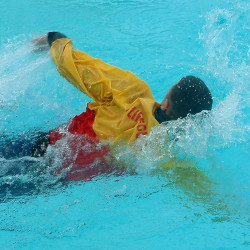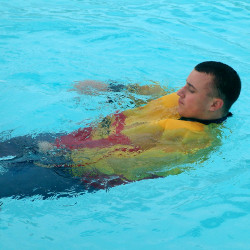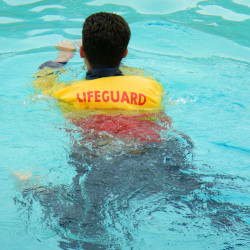Improve Your Swimming Skills
Swimming is a low impact sport and enjoyable when done right. You'll blast fat while sculpting your major muscles.
You can swim a lot faster with the same effort when you use the right technique and effective skills. Most people focus on increasing their propulsion through the water, giving their body alignment little or no thought. Studies show that proper technique can make you swim up to 50% faster. The trick is to glide through the water like a fish.
Know Your Abilities
Know your body and what you can realistically do. Practice strokes you know, but learn more than one swimming stroke. Breaststroke, backstroke, and side stroke can all be used to give you a rest from front crawl and help you to stay on course. If you do a stroke the wrong way, you may encounter some discomfort.

Front Crawl / Freestyle

Backstroke using legs only

Breaststroke
Three Fundamentals of Swimming
Balance
The position of head and lungs affect your balance in the water. Most people swim with their head up, especially with breaststroke. Lifesavers often use the head-up swim to keep an eye on their casualty. This forces their hips to sink down. It is like they are swimming uphill and a somewhat less comfortable. The higher your head is out of the water, the steeper your swimming angle, the slower you go.If your body is flat/horizontal or more parallel to the water-line your swimming is far more effective and you feel more comfortable in the water.
Length
The taller the person is, the faster their speed through the water. It is important that you are fully stretched horizontally in the water, as this will reduce your body's drag through the water and allow a higher speed.
Rotation
In most sports, such as baseball, when the batter swings the baseball bat they will rotate the hips to increase the power of the swing. The same principle is applied to swimming. If you engage your hips and use your body's core muscles it will increase power.
Efficient Swimming Stroke
An efficient swim stroke significantly reduces wasted energy output through less drag in the water and a cleaner execution of hand and arm entry and recovery. When considering a swimming technique for any stroke, analysis should follow the format described below, in this order:
- Leg kick
- Arm cycle
- Timing
- Breathing
The leg kick controls your body position in the water, while the arm cycle will provide the propulsive force. The timing between the two is vital to the efficiency of the given stroke for a greater speed through the water with minimum wasted energy.
Analyse and improve your breathing technique so it does not disrupt your overall technique and reduce your efficiency. Imagine a straight line going from your starting point to your finish point. Keep your entire body parallel to this straight line at all times. Think about cutting through the water, not fighting against it.
Work on your body alignment to improve your swimming times.
Shaping your body like a vessel has more impact on your time than hand movement.
Refine Your Swimming Strokes
To reduce drag, you should be consciously aware of what your body is doing. Reduce and then eliminate any actions that aren’t required to propel you forward. Have a friend video you while you swim so that you can see how you’re swimming.
In swimwear or speedy bodysuits you may get away with a bad swimming stroke.
You still move ahead somehow.
The moment you tow a casualty or wear clothes that slow you down,
you'll notice how bad your stroke might be and that you're not going anywhere fast.
The total distance of each session starts at 500 m or 20 lengths,
and slightly increases through the weeks.
There are no time limits, as the main goal is to achieve the distances throughout the training.
Add five more lengths and one clothing item every week.
This builds more strength over time.
Here’s where the fun starts!
Take advantage of a long set, like repeat 300s or 400s, and put swimmers of similar abilities in the same lanes.
Each swimmer should start one second apart, basically one after another, and try to stay right on the leader’s feet.
Don’t forget to alternate who leads the lane after each interval.
During a normal swim set, every wall is a chance to rest, relax and recover before the next lap.
However, there are no walls every 25 or 50 meters in the open water.
One way to prepare yourself is by doing a long swim (500 to 1000 meters) without touching the wall.
Instead of turning at the wall and pushing off with your legs, flip at the T (at the end of the underwater lane marker),
or five feet before the wall.
You will lose all of your forward momentum and be forced to use your arms and legs to get moving again.
Caution: This can be stressful on your shoulders, so be sure to also use your legs to accelerate after you flip.
As with all activities, don’t overdo it.
Rarely will a triathlon or open-water swim have a 180-degree turn on the course,
as sending swimmers head-on toward competitors is not the best idea.
Thus, 90-degree turns are the norm.
Pretend there is a buoy in the middle of your lane, swim towards it and make a U-turn around it.
You can put a teammate or your coach onto an inflated buoy,
use a mark on the bottom of the pool, or just your imagination.
The point is: Practice your turns!
Do some 180-degree turns as well.
It can’t hurt to be over-prepared!
These fun and challenging drills can be incorporated into a regular swimming practice.
After a while, training in the pool can get a bit repetitive and anything to mix up the tedium is a welcome change.
Not only will these drills give you a mental boost, they will also prepare you for your first, second or 100th adventure.
Be creative, original and inventive with your skills.
These are just some guidelines to inspire your own training ideas.
Combine multiple skills to make another day at the pool more enjoyable.
Remember, the most important thing is to feel confident and prepared when you are starting your open water adventure.
This didn't convince me at first,
but our swim team practices all swimming strokes fully clothed to get them right.
Why?
Our coach said that a bad swim stroke can go unnoticed when wearing just swimwear.
When you swim in clothes,
it makes a remarkable difference if you do a swim stroke right or wrong.
Get the skill wrong and you slow down a lot because of the drag.
Hence our team coach recommends that we wear clothes for all swimming sessions and strength training.
This was noticed especially by our competition swimmers.
Their results improved much faster.
Anyway, swimsuits are for wimps, says our coach.
The key factor in swimming is your technique.
When you swim in clothes, a bad technique will slow you down a lot
and quickly highlight issues with your swimming stroke.
The added resistance requires that you adapt your swimming stroke and fine tune it.
Any adjustments you make will immediately result in a clear diffrence of speed and effort.
This gives you the right feedback you need to adjust your stroke.
You can quickly see where you can do better.
Small adjustments show immediate results that will improve your overall technique.
As soon as you improve your skill, your speed picks up quickly.
Drafting
Flip at the T
Turn in the Middle
Summary
Reader Comment: Powerful Training Tip
by Robert, Toronto, Canada